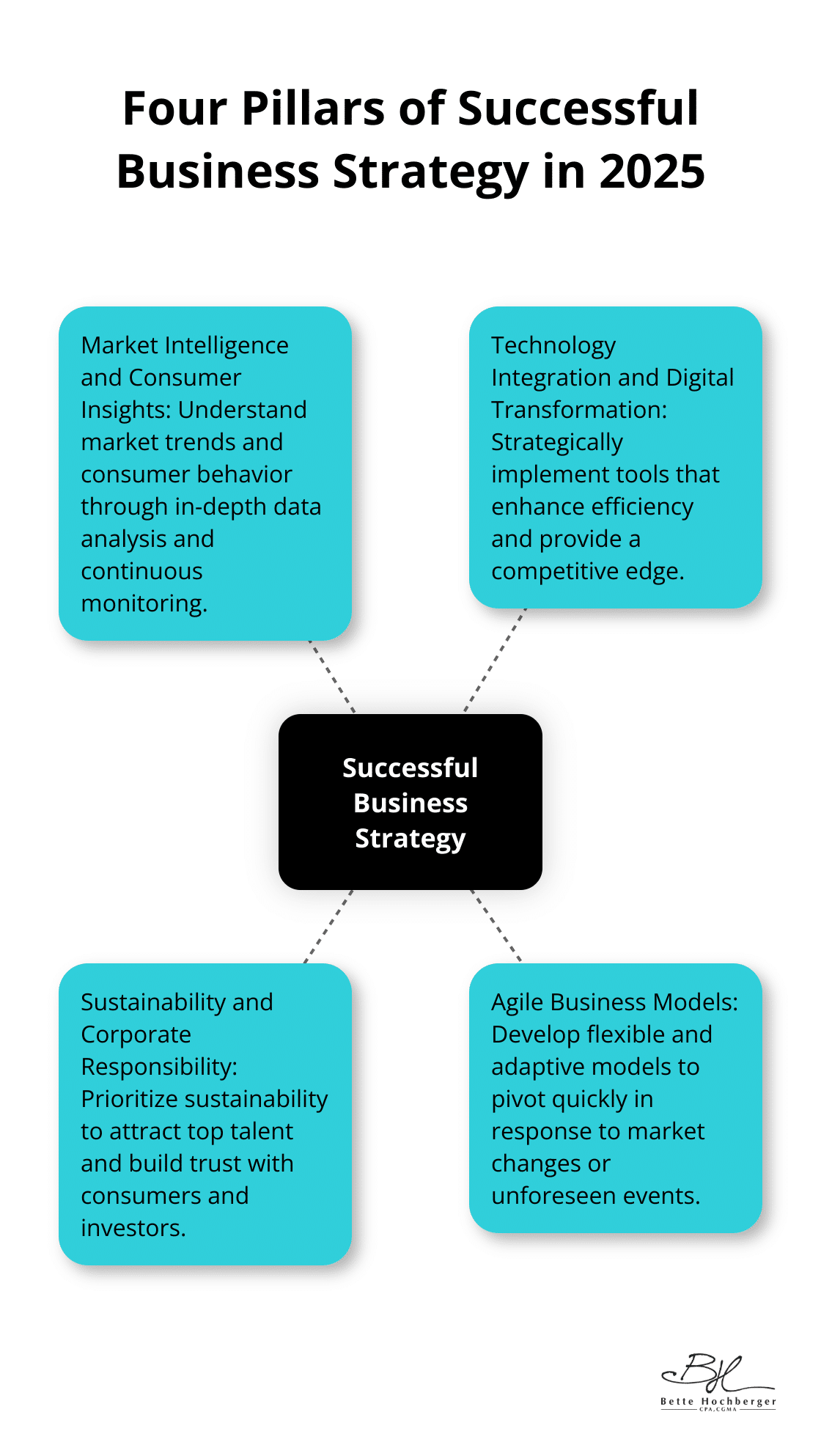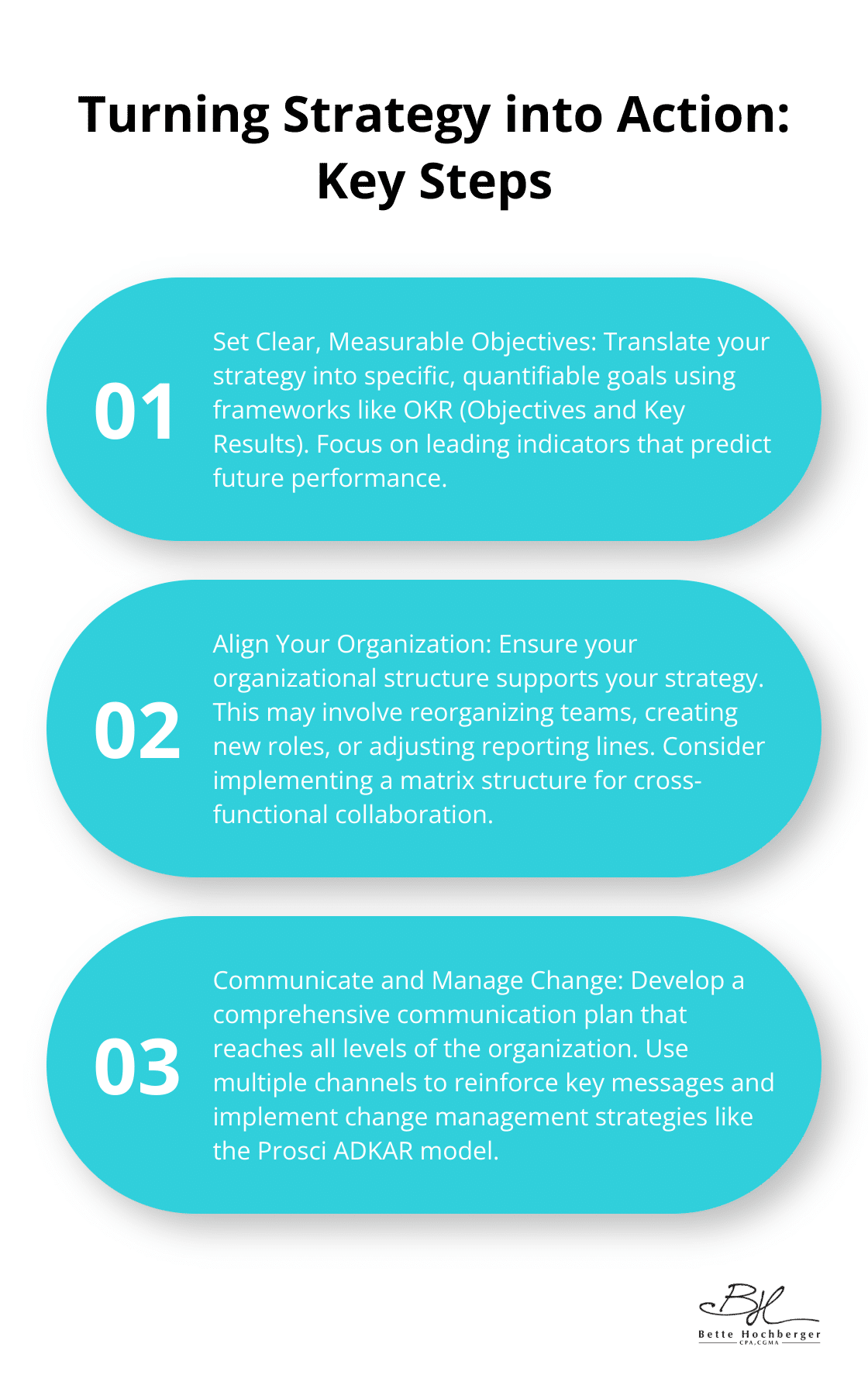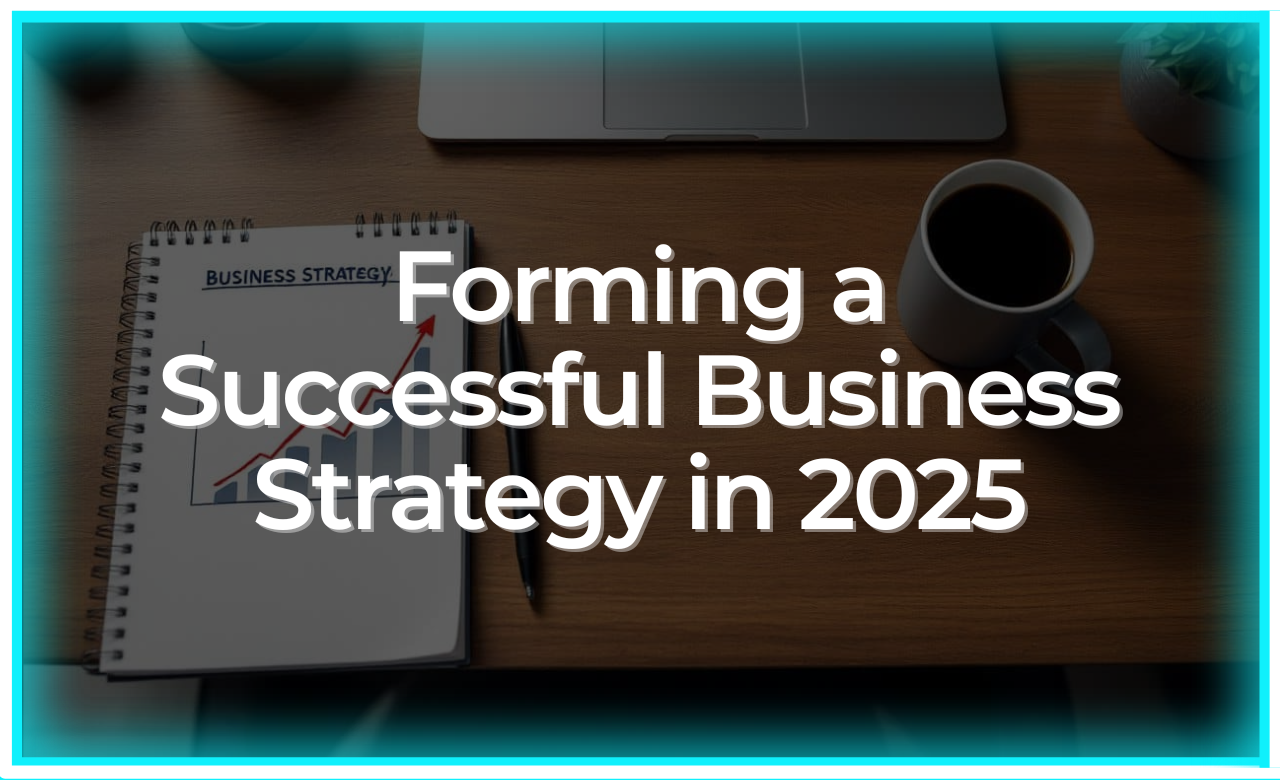Hi everyone! I’m Bette Hochberger, CPA, CGMA. In 2025, crafting a successful business strategy is more critical than ever. The rapid pace of technological advancements and shifting market dynamics demand a fresh approach to strategic planning.
At our firm, we’ve seen firsthand how a well-designed business strategy can propel companies to new heights. This post will guide you through the key components, competitive strategies, and implementation techniques for developing a winning business strategy in today’s complex landscape.
Key Components of a Successful Business Strategy in 2025
A successful business strategy in 2025 rests on four pillars that shape the modern business landscape. These components form the foundation for companies to thrive in an ever-evolving market.

Market Intelligence and Consumer Insights
Businesses must understand market trends and consumer behavior at a granular level. This requires in-depth data analysis and continuous monitoring of consumer preferences. The 2025 Edelman Trust Barometer highlights that globalization, economic, and technology fears worsen job insecurity. Companies can use this information to develop products or services that address these concerns directly.
Technology Integration and Digital Transformation
The integration of technology has become a necessity, not an option. Companies that fail to adopt these technologies risk obsolescence. However, this doesn’t mean blindly following every tech trend. The key lies in strategic implementation of tools that enhance efficiency and provide a competitive edge.
Sustainability and Corporate Responsibility
Sustainability now stands at the forefront of business priorities. Companies that prioritize sustainability not only attract top talent but also build trust with consumers and investors (a win-win situation).
Gaining the Edge in 2025’s Competitive Landscape
In 2025’s fiercely competitive business environment, companies must surpass traditional strategies to stand out. The focus shifts to four key areas: innovation, brand strength, operational excellence, and talent development.
Innovate to Thrive
Innovation becomes a necessity for survival. Companies must evolve their products, services, and processes continuously to maintain relevance. The most successful organizations use innovation to expand their lead within their industries and disrupt new ones, even in uncertain times. To foster innovation, businesses should:
- Allocate resources to research and development
- Encourage cross-functional collaboration
- Create a culture that rewards creative thinking
An effective approach involves implementing an innovation pipeline. This structured process helps companies generate, evaluate, and implement new ideas systematically. For example, 3M’s “15% time” policy allows employees to spend 15% of their work time on projects of their choosing, which has led to breakthrough products (like Post-it Notes).
Build a Resonant Brand
A strong brand identity differentiates powerfully. In an age of information overload, customers gravitate towards brands they trust and connect with emotionally. The 2024 Edelman Trust Barometer revealed that 84% of consumers need to share values with a brand in order to buy it.

To build a strong brand, companies should:
- Focus on consistency across all touchpoints (from marketing materials to customer service interactions)
- Align their brand values with those of their target audience
Optimize for Agility
Cloud-based technologies and data analytics tools can significantly enhance operational agility. These technologies allow for real-time decision-making and rapid scaling of operations. Amazon’s use of predictive analytics in its supply chain management allows it to anticipate demand and adjust inventory levels accordingly, reducing costs and improving customer satisfaction.
Invest in Human Capital
In an era where talent is a key differentiator, employee development investment becomes paramount. The World Economic Forum predicts that by 2025, 50% of all employees will need reskilling as technology adoption increases.
Companies should:
- Implement comprehensive training programs focusing on both technical and soft skills (like adaptability and critical thinking)
- Create clear career progression paths
- Offer competitive benefits packages
Google’s “20% time” policy (which allows employees to spend one day a week on side projects) has not only led to innovations like Gmail but also increased employee satisfaction and retention.
These strategies can transform businesses, positioning them for success in 2025’s competitive landscape. However, effective implementation requires careful planning and execution. The next section will explore how to turn these strategies into actionable plans and measurable results. Competitive business demands strong financial leadership, and considering options like a contract CFO can provide valuable expertise without the commitment of a full-time hire.
Turning Strategy into Action
Effective implementation of business strategy often determines success or failure. In 2025, this process requires precision, flexibility, and a data-driven approach. Here’s how to transform your strategic vision into tangible results.

Set Clear, Measurable Objectives
Translate your strategy into specific, quantifiable goals. The OKR (Objectives and Key Results) framework provides an excellent structure for this. For example, if your strategy involves expanding market share, an objective might state: “Increase market share by 5% in the next 12 months.” Key results could include “Launch three new product lines” and “Expand into two new geographic markets.”
Align Your Organization
Your organizational structure must support your strategy. This might require reorganizing teams, creating new roles, or adjusting reporting lines. A McKinsey survey revealed that 70% of complex, large-scale change programs fail. To combat this, involve key stakeholders in the restructuring process and clearly communicate how changes align with strategic goals.
Consider implementing a matrix structure if your strategy requires cross-functional collaboration. This approach allows for both functional expertise and project-based flexibility (as successfully used by companies like Procter & Gamble).
Communicate and Manage Change
Effective communication plays a vital role in successful strategy implementation. Develop a comprehensive communication plan that reaches all levels of the organization. Use multiple channels – town halls, team meetings, internal newsletters, and digital platforms – to reinforce key messages.
Change management holds equal importance. The Prosci ADKAR model (Awareness, Desire, Knowledge, Ability, Reinforcement) provides a useful framework for guiding employees through change. Invest in training programs to equip your team with the skills needed to execute the new strategy. The Association for Talent Development reports that companies offering comprehensive training programs have 218% higher income per employee than those with less comprehensive training.
Monitor and Adjust Continuously
In today’s fast-paced business environment, your strategy can’t remain static. Implement a system for continuous monitoring and adjustment. Use real-time data analytics to track key performance indicators (KPIs) and identify trends or issues early.
Regular strategy review meetings are essential. Jeff Bezos of Amazon famously uses a “two-pizza team” rule for these meetings (if two pizzas can’t feed the group, it’s too large for effective decision-making).
Strategy implementation requires commitment, flexibility, and a willingness to learn and adapt. These principles will position you well to turn your strategic vision into reality in the dynamic business landscape of 2025.
Final Thoughts
A successful business strategy in 2025 requires a multifaceted approach. Market intelligence, technological integration, sustainability, and agility form the foundation for companies to thrive in an increasingly competitive landscape. Innovation, brand strength, operational excellence, and talent development emerge as key differentiators that drive growth and open new market opportunities.
The implementation of a well-crafted business strategy demands clear objectives, organizational alignment, and effective communication. Companies must continuously monitor and adjust their strategies in response to market shifts, technological advancements, and changing consumer preferences. Those who embrace change position themselves for long-term success, while rigid organizations risk obsolescence.
We specialize in helping businesses navigate complex financial landscapes. Our expertise in strategic tax planning, Fractional CFO services, and cash flow management can provide valuable insights as you craft your business strategy. We can help you minimize tax liabilities, optimize operations, and ensure profitability in the dynamic business environment of 2025.










